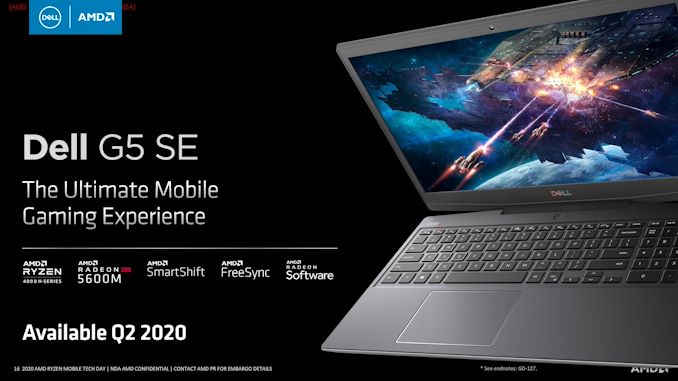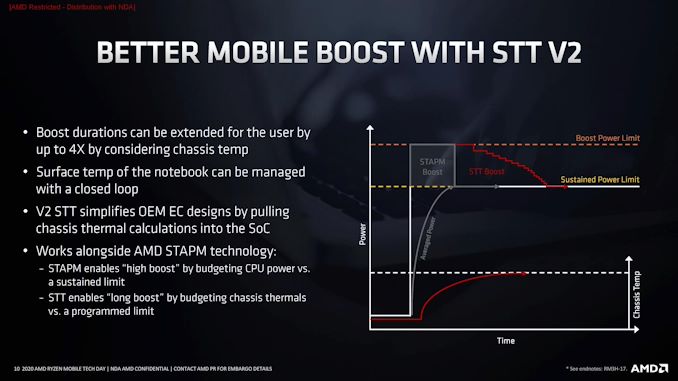AMD Details Renoir: The Ryzen Mobile 4000 Series 7nm APU Uncovered
by Dr. Ian Cutress on March 16, 2020 11:00 AM ESTAMD SmartShift
We’ve covered AMD’s SmartShift before, when it was announced at CES, as a technology that allows a system management controller to interact with both the mobile APU and an AMD graphics card in the same system in order to shift power where it is needed. This solution is still based on separate power rails between the two, however the use of the scalable control fabric (SCF) part of Infinity Fabric means that parts of the APU and parts of the GPU can interact together in this way. Ultimately AMD believes they can score 10-12% better on heavy CPU workloads like CineBench or gaming workloads like The Division.
The solution is firmware based, but requires interaction between qualified hardware. AMD states that often in these sorts of CPU+GPU designs, while the chassis has a total design TDP, if one of the elements of the system is idle, then the other can’t take advantage of the extra turbo headroom available. SmartShift aims to fix that.
What’s new here is that AMD is primarily focus will be on Ryzen Mobile 4000 + Vega 10 style systems. The first one with SmartShift enabled will be the Dell G5 SE. The Dell G5 SE is being labelled as ‘the ultimate mobile gaming experience’, and will feature a new H-series processor, the Radeon RX 5600M, SmartShift, FreeSync, and have a 15-inch display. The unit will be coming out in Q2.
System Temperature Tracking (Version 2)
SmartShift is also part of a new System Temperature Tracking paradigm that AMD is implementing in its new APUs. Even if there is power headroom, a system can’t turbo if there isn’t thermal headroom. Smart Temperature Tracing v2 (or STTv2) is designed to help a system boost for longer by knowing more about the thermal profile of the device.
My placing additional thermal probes inside the system, such as on hot controllers or discrete GPUs, the readings of these can be passed through the Infinity Fabric to an embedded management controller. Through learning how the system thermals interact when different elements are loaded, the controller can determine if the system still has headroom to stay in turbo for longer than the current methodology (AMD’s Skin Temperature Aware Power Management). This means that rather than having a small number of sensors getting a single number for the temerpature of the system, AMD takes in many more values to evaluate a thermal profile of what areas of the system are affected at what point.
What STTv2 does at the end of the day is potentially extend the boost time for a given system, depending on its thermal capabilities. For example, the Lenovo Yoga Slim 7 which we are expecting for review only has a 15 W processor inside, but the chassis has been built for a 25 W TDP design, which means that STTv2 should kick in and provide the user with peak performance for longer.














95 Comments
View All Comments
Namisecond - Thursday, March 26, 2020 - link
Are you sure you don't mean an XPS 15 rather than the 13? The 13's have traditionally use U-class processors rather than H-class.deksman2 - Monday, March 16, 2020 - link
The iGP should be about 30% faster than Zen+.AMD improved Vega iGP uArch in Zen 2 mobile, so that per core, that Vega is now 56% faster than Zen+.
The Zen 2 mobile Vega iGP does apparently have lower amount of compute units, but because of improved performance per core, the iGP should still be about 30% faster than previous iterations.
So, yes, I do think games set to Medium settings and 1080p should work fine... more to the point, since these APU's also apparently support LPDDR4 with high frequencies, bandwidth won't be a problem... so hypothetically at least we could see even better performance.
Those improvements that went into Zen 2 mobile Vega will also be integrated in RDNA2.
LittlePaul - Monday, March 16, 2020 - link
I am wondering on the top left of the die shot, it looks like 64-bit GDDR6 controller comparing to Navi 10 die shot (exactly the same and way different to Piccasso )I am dreaming, right?
Spunjji - Tuesday, March 17, 2020 - link
Isn't that the CPU cores? Pretty sure that's what it is.uibo - Monday, March 16, 2020 - link
The Renoir APU graph on the first page has a block called "video codec next 2". I thought the engine was called "Video core next"?edzieba - Monday, March 16, 2020 - link
Note that AMD have chosen power-under-load as their look-at-the-big-number-we-have 'slide headline' figure, whilst the killer when it came to battery life for Ryzen Mobile 2xxx/3xxx was idle power.Fataliity - Monday, March 16, 2020 - link
There are slides on other sites, like notebookcheck.com and the video from the australians (hardware unboxed i think) That show the actual slides, and the data AMD themselves got.1065G7 still wins in some idles, but renoir pulls ahead in actual use it seems. Which evens out to about equal / slightly better for Renoir, depending on how you weigh it.
Spunjji - Tuesday, March 17, 2020 - link
They mention a number of improvements to idle, too - particularly from the Infinity Fabric, which was their big weakness before.anonomouse - Monday, March 16, 2020 - link
" Compared to the desktop design, the mobile is listed as being ‘optimized for mobile’, primarily by the smaller L3 cache – only 4 MB per quad-core group, rather than the 32 MB per quad-core group we see on the desktop"Isn't it 16MB per CCX on desktop?
Farfolomew - Tuesday, March 24, 2020 - link
I saw that too and questioned its validity. 32mb per 4-cores? That seems really high (I can't remember what it was reading the Zen2 desktop review last year) and if it's the case, that's a huge cut down for the mobile line